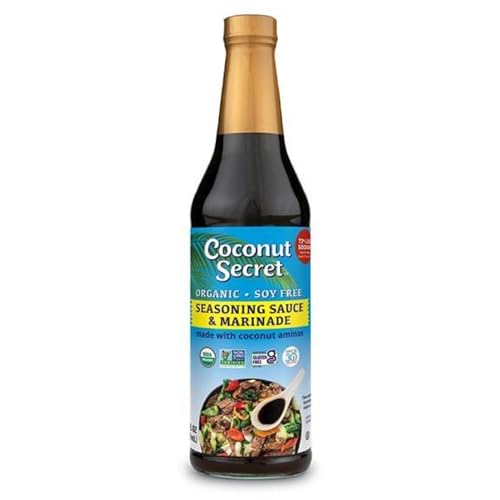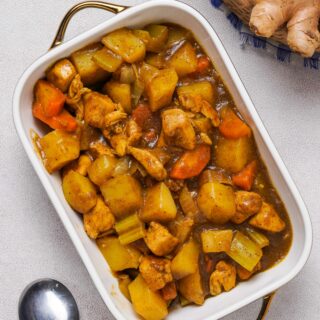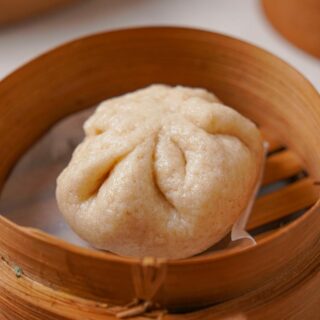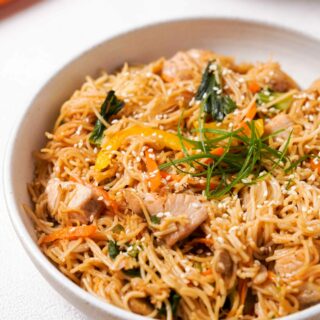Soy sauce is the most used sauce in Asian cooking and is used to spice up everything from stir fries to dumplings and sushi rolls. You’ll find it in kitchens, grocery stores, and restaurants worldwide.
The most important question though: is soy sauce gluten-free? Spoiler: there is gluten in soy sauce. But don’t worry, we’re here to share with you the best gluten-free soy sauce alternatives and brand recommendations so you don’t have to miss out — because that would be a travesty!
Is Soy Sauce Gluten-Free?
Does soy sauce have gluten in it? Yes, most soy sauce bottles include wheat and are therefore not gluten-free.
Why Is Soy Sauce Not Gluten-Free?
So, why does soy sauce have gluten? Well, it’s all about the fermentation process.
You see, soy sauce is traditionally made from a fermented soybean paste. The soybeans are soaked overnight in water, cooked, and then fermented alongside crushed wheat berries. It’s a long process to make the Asian liquid condiment we adore worldwide today.
Can you even enjoy sushi without a little dish filled with the salty umami flavoring? We think not!
Related: Wondering if sushi is also gluten-free?
What Soy Sauce Is Gluten-Free?
The main gluten-free soy sauce widely available is tamari sauce or tamari soy sauce. To make tamari, soybeans are fermented with rice instead of wheat.
Some people can’t tell the difference between tamari and soy sauce, while others say it has a richer, more balanced, and less salty flavor. We’ll let you be the judge.
How to Shop For Gluten-Free Soy Sauce
Here are some helpful shopping tips when buying gluten-free soy sauce.
- Always read the label. You always want to pay attention to labels and double-check that the product you pick up is gluten-free. This is particularly important for soy sauce as popular brands like Kikkoman have glutinous and gluten-free soy sauce available. So you need to make sure you’re buying the right product.
- Shop our list of recommendations. Checking out our list of gluten-free soy sauce brands below is a great starting point.
- Choose a gluten-free soy sauce alternative. While you can try tamari sauce or gluten-free soy sauce, we’ve included other alternatives below. Coconut and liquid aminos are gluten-free and soy-free and give your dishes the same savory flavor that soy sauce does.
- Visit one of these retailers. Amazon, Walmart, Target, and Thrive Market all sell gluten-free soy sauce. Whole Foods also has coconut aminos available.
Gluten-Free Soy Sauce Brands
Here are our recommendations for the best gluten-free soy sauce brands.
Aloha Shoyu
Aloha Shoyu’s gluten-free soy sauce is very popular among Hawaiian residents and visitors alike, so we think it’s about time we see what the hype is about. It’s uniquely made with fermented Japanese soybeans using traditional practices for a flavor profile they call “both bold and nuanced.” With less salt than traditional tamari, it’s a winner in our books.
Kikkoman
Kikkoman is probably the most popular soy sauce brand in the States. Fortunately, they’ve caught on and they now produce a gluten-free soy sauce, which is certified gluten-free by the Gluten Intolerance Group of North America. The soy sauce is made from four simple ingredients: soybeans, water, salt, and rice with no preservatives. They used the same traditional age-old brewing process they’re known for to make this gluten-free soy sauce alternative.
Another option is their gluten-free tamari soy sauce. This is also certified gluten-free and made with four ingredients: water, soybeans, salt, and sugar. Which will you choose?
La Choy
Now, La Choy’s soy sauce is gluten-free, according to the ingredients, their website, and their Amazon listing. However, only their lite soy sauce, which contains 55% less sodium than their regular soy sauce, has a gluten-free label. So we’ll let you decide which product you try.
Lee Kum Kee
Lee Kum Kee is a well-known brand in the Asian condiment space. Fortunately, they have gluten-free soy sauce in stores. It’s made from water, soybeans, salt, sugar, and cornstarch. But Lee Kum Kee assures gluten-free customers that they can expect the same “rich savory flavor and aroma from the leader in authentic Chinese sauces.”
Related: While we’re on the topic of Asian condiments, find out whether teriyaki sauce is gluten-free.
Ohsawa
Ohsawa offers a tamari soy sauce that’s wheat-free, certified organic, and kosher. It’s produced by the Deguchi family in Japan’s Chita Peninsula and traditionally brewed using time-honored methods passed down through the generations.
San-J
San-J is another soy sauce brand you’ve probably seen on shelves. Well, they have a few gluten-free options for celiacs. You might like to start with their gluten-free tamari soy sauce. Made with 100% soy, San-J says it has a “richer, milder, more complex taste” than regular soy sauce. It’s also vegan, kosher, certified gluten-free, and FODMAP-friendly.
Now, the other options. San-J also has organic gluten-free tamari and what they call Tamari Lite. This is still gluten-free but has 50% less sodium than San-J’s regular soy sauce. San-J confirms that it tests its products and they each contain less than five parts per million of gluten (the safe zone for celiacs is less than 20 ppm).
Soy Sauce Brands to Avoid
There are a lot of soy sauce brands out there. So if we listed all the brands to avoid, well, we’d be here all day! The key thing is to double-check that you’re buying a gluten-free product. This is because the brands mentioned, like San-J, Kikkoman, Le Choy, and Lee Kum Kee, have both gluten-free and glutinous soy sauces available.
Gluten-Free Soy Sauce Alternatives
If you want to try something different or have a soy allergy, here are three gluten-free soy sauce alternatives:
Coconut Aminos
Have you heard of coconut aminos before? It’s a savory condiment that’s very similar to soy sauce; it’s just typically lighter in color and a pinch sweeter. As the name suggests, it’s made from coconut palm sap, which ferments and ages just like the soybeans in soy sauce.
There are a couple of brands available, but the most popular is undoubtedly Coconut Secret’s coconut aminos. It’s made from organic coconut tree sap and mineral-rich sea salt. That’s it. It also contains 73 percent less sodium than traditional soy sauce. If that’s not enough, this coconut aminos is USDA-certified organic, gluten-free, vegan, and contains no MSG.
Big Tree Farms also has coconut aminos that tick all the boxes. Seriously, it’s soy-free, vegan, gluten-free, paleo, certified kosher, and Whole30-approved. It’s also made from just two ingredients: organic coconut flower blossom nectar and Balinese sea salt.
A final option is available from BetterBody Foods.
Liquid Aminos
So coconut aminos are technically a type of liquid aminos. But another type is actually made from soybeans. The soybeans are typically treated with acid to break them down and transform them into free amino acids.
Bragg Liquid Aminos is extremely popular and it’s made with just two ingredients: certified non-GMO soybeans and purified water. Just like coconut aminos, it has a lot less sodium than regular soy sauce, too.
“No Soy” Soy Sauce
Besides aminos, the final option is “no soy” soy sauce. This is typically made from fermented peas and pea protein. San-J’s No Soy Tamari doesn’t contain the eight major allergens, so it’s a great choice for many. They also promise that their soy-free sauce has the same umami-rich flavor as soy sauce.
Sempio also has a No Soy Sauce that’s vegan, gluten-free, allergen-free, and keto-friendly.
A final option is Ocean Halo’s No Soy Soy-Free Sauce. This is USDA-certified organic, certified vegan, and gluten-free. The ingredients are really unique, too, as it’s made with molasses, apple cider vinegar, lime juice, dried kelp, and mushrooms.
Recipes That Use Gluten-Free Soy Sauce
Now you have your shopping basket full of gluten-free soy sauce options, you’re probably after some recipes. Here are some of our favorites that use soy sauce:
- You won’t even realize this pad thai is gluten-free!
- Make a healthy and gluten-free version of orange chicken, a takeout specialty.
- Gluten-free soy sauce adds the perfect amount of savory flavor to this curry’s creamy coconut milk sauce.
- Nothing tastes better on a cool night than a big bowl of homemade gluten-free ramen.
- Soy sauce completes appetizers like gluten-free potstickers and gluten-free egg roll wrappers.
- Make our four-ingredient Hawaiian chicken with gluten-free soy sauce.
- We couldn’t forget about everyone’s favorite: the best gluten-free fried rice recipe and the only one you’ll ever need.
Frequently Asked Questions
Is Soy Sauce Okay for Celiacs?
No, traditional soy sauce is not okay for celiacs as it contains wheat. But check out our recommendations for gluten-free soy sauce brands.
Why Is There Gluten in Soy Sauce?
Soy sauce has gluten because the traditional way of making the condiment includes fermenting cooked soybeans with crushed wheat.
How Much Gluten Is in Soy Sauce?
Not enough research has been done to confirm the amount of gluten in soy sauce. It’s undetermined whether the fermentation process breaks down the wheat proteins that celiacs have an intolerance toward. But we assume that there are more than 20 parts per million of gluten in a bottle of soy sauce, which is the FDA’s ruling on gluten-free labeling. As mentioned, if there’s less than 20 ppm, the FDA determines it’s safe for celiacs.
There’s No Need to Say Goodbye to Soy Sauce
So, is soy sauce gluten-free? No — but lucky for us, there are plenty of gluten-free soy sauce alternatives. Follow our shopping tips and brand recommendations and you’ll be set.
Now, if you’ll excuse us, I think a gluten-free stir-fry is calling our name!

















Leave a Question or Comment